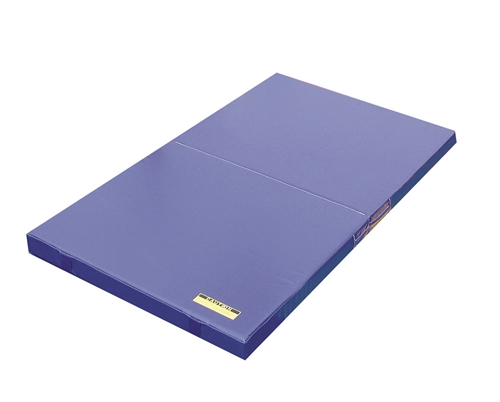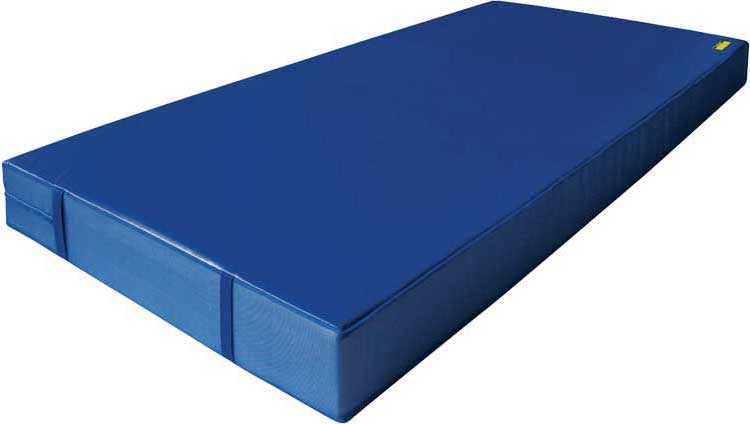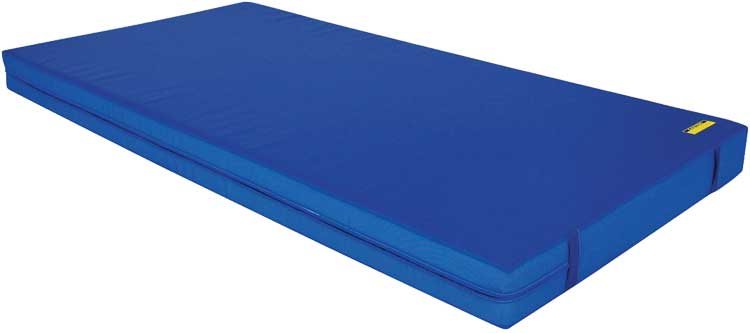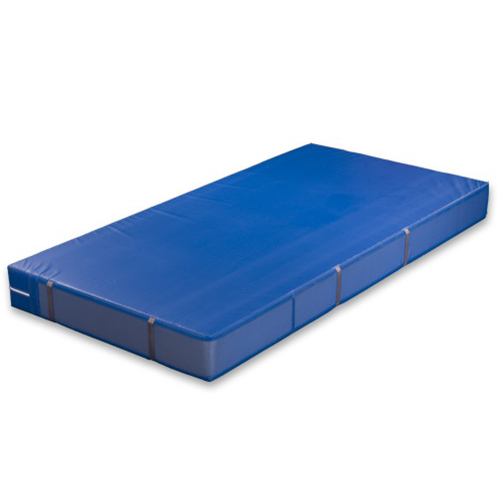Mat (gymnastics)
Mats for sport find their main application in the turn sports such as Gymnastics, the floor exercise or even children's gymnastics, but also in martial arts such as judo or wrestling. They serve to make the landing of the athlete so soft and joint gently as possible in order to prevent injuries.
- 3.1 Areas of application
- 3.2 Dimensions and weights
- 5.1 Matt core 5.1.1 composite foam
- 5.1.2 neopolen
- 5.1.3 PE foam
- 5.1.4 PU foam
- 5.2.1 Polygrip Turn Matting
- 5.2.2 pipped Turn Matting
- 5.2.3 tarpaulin
- 5.2.4 needled
Purpose and characteristics
Because of their properties and the resulting use of exercise mats are divided into four main types. The characteristic of the sport mat determines their use. The essential characteristics are the degree of attenuation ( depth ) and the resilience, ie, the ability of the mat, the original form and the original dimensions of picking it up again, after completed the landing of the athlete and the forces acting on them are eliminated.
Soft floor mat
Landing mat
Floor exercise mat
Gym mats
The exercise mat is versatile and has a good recovery, but a low damping behavior. Therefore it is not suitable for sports where the athletes from more than 60 cm in height lands on the mat.
Soft floor mats
The soft floor mat has a very high penetration depth and thus dampens the landing very strong. Thus this type of mat is used in sports with uncontrolled landing. The soft floor mat is unsuitable for sports with a point landing (eg Gymnastics ): Feet and hands can "caught" during landing due to the high penetration depth (so-called " vice " effect), which can lead to injury.
Landing mats
Characteristic for this type of mat is a smaller penetration depth. Therefore, there is the Landing mat for demanding sports with rotations. However, this mat is not suitable for children up to primary school age. Due to the low weight of the children, the body does not sink into the mat, the jump is not attenuated.
Floor Exercise mats
Floor Exercise mat, also called runners, the sports mat with the largest area (standard length 6 or 12 m and standard width 2 m), but is very thin (about 3.5 cm). The floor exercise mat is mainly used in rhythmic gymnastics, acrobatics and gymnastics used. Given their dimensions, this mat is also in the school sector use as a cover for Matt spaces or as a support on soft floor mats, with the aim of ensuring a better level with the landing of the athlete.
Classification of sports mats by type
The German Institute for Standardization (DIN) has named a total of twelve different types of mats, including design and application:
- Type 1: mat for floor gymnastic exercises without jumps (for beginners)
- Type 2: mat for floor gymnastic exercises with jumps
- Type 3: mat for floor gymnastic exercises with jumps and for low jumps
- Type 4: mat for easy disposal of equipment controlled landing
- Type 5: landing mat
- Type 6: mat for difficult Disposals
- Type 7: The soft floor mat for simple exercises
- Type 8: soft floor mat
- Type 9: High jump mats (school, training)
- Type 10: High jump mats ( competition )
- Type 11: Pole Vault mats (school, training)
- Type 12: judo mats
Technical details
Applications
Dimensions and weights
All angles of the respective mat must be square.
Manufacture of gym mats
In the so-called laminated gym mats of fabric is firmly glued to the mat core. Characterized the formation of wrinkles is prevented. The mats are generally provided with a bottom which does not slip.
Classic made gym mats consist of the mat core and a coating which can be exchanged under certain circumstances. A fleece backing is no longer necessary unless abrasion resistant foam is used for the mat core. Nevertheless, the fleece backing still is used because it simplifies coating the mat envelope over the foam core.
According to European standards leather corners and the different forms of compound flaps are allowed. Where available handles or carrying straps should be designed on the mats so that they fit snugly against the mats, so that no column in the juxtaposition of the mats produced.
Material
The first sports mats were originally woven from knitting and later replaced by coconut fibers. These were relatively inexpensive to manufacture and were characterized by a long service life. However, due to the nature of this material, these mats were very susceptible to dirt, so that they were soon replaced by mats of leather with padding. In order to save leather, this was later replaced by canvas mats, at the bottom there was a Chromledergleitschutz. Today, both the core and the surface of sport mats are made mainly of plastic material.
Matt core
The core of a mat is responsible for optimal cushioning, which can only be ensured through standard gym mats. The corresponding values are defined in the new European standard fonts. The core is usually made of foam, with composite foams or polyethylene - light foam types for this purpose are best suited.
Neopolen
PE foam
PU foam
Composite foam
For the mat core of a sports mat, a foam from foam flakes suitable. These are pressed and glued in a special procedure. By using this material the mat stands out as particularly resistant and is still elastic.
- Density (RG): ≈ 80, 100 or 120 kg / m³ ( at gym mats )
- Use: As device gymnastics mat (RG 100 RG 120) for landing and drop height of 0.60 m or as a floor exercise mat.
Neopolen
Polypropylene foam expanded, predominantly closed-cell foam particles. Sport mats with this core are characterized by a good recovery from after static and dynamic loading.
- Density (RG ): 32 kg / m³
- Purpose: as a Gymnastics Mat ( Lightweight gym mat) for landing and drop height of 0.60 m.
PE foam
In sports boots polyethylene foam is overlaid and bonded in a sandwich construction in several layers. Mats with a core of polyethylene foam are characterized by a high stability with low weight.
- Density (RG): ≈ 30 kg / m³ ( for gym mats ).
- Purpose: as a floor exercise mat
PU foam
Sport mats in which polyurethane foam is used as the material for the mat core to have a high dimensional stability. Therefore, polyurethane foam is primarily used for the production of soft floor mats.
- Density: at least 20 kg / m³
Matt surface
Pipped Turn Matting
Tarpaulin
Needled
Polygrip Turn Matting
- Polyester fabric with plastic coating
- Tensile strength: 2,500 N
- 600 g / m
- Grain structure
- Slip-resistant
Pipped Turn Matting
- Polyester fabric with plastic coating
- Tensile strength: at least 2,500 N
- Slip-resistant
- Knob structure
- Protection against skin burn
Tarpaulin
Needled
- No formation of wrinkles by firm adhesion of core and surface
- No fire injuries
- Skin-friendly
- Sure-footed
Security
There are currently the following European standards for tested quality mats:
- EN 12503-1 gym mats - Safety requirements (1-3)
- EN 12503-2 high jump and pole vault mats
- EN 12503-3 judo mats
- EN 12503-4 Determination of shock absorption
- EN 12503-5 Determination of the frictional properties of the bottom
- EN 12503-6 Determination of the frictional properties of the top
- EN 12503-7 Determination of the static properties
Various additional standards were also prepared by the member countries. However, these do not affect the safety requirements.
In order for a sport mat can fill their function adequately, they must meet the following safety requirements.
To ensure safety, the mat core should be either collapsed or depressed. Shell and core of the mat must also be such, that is no merkbares sliding between the core and shell. In addition, the slip resistance of the mat is required. To prevent any accident should a sports mat also have no carrying handles. In order to transport the mat, so many manufacturers use tight-fitting handles.










